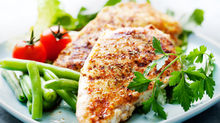Answers to the question: “Can I eat bread and which one is the best?”
Has everyone had a good week and made it to the gym at least once?
All this exercise we do isn’t possible without the carbohydrates in our daily diets and we talk about our healthy eating programs at length during our sessions.
One question that pops up regularly is “Can I eat bread and which one is the best?"
So our body needs a certain amount of carbohydrate from our diet to fuel our physical activity. When eaten, the body converts most carbohydrates into glucose (sugar), which is used to fuel cells such as those of the brain and muscles.
So if bread is mostly carbohydrate and we embrace eating carbs to a degree...surely bread is fine to consume?
1. Eat only whole grain bread
The fibre content of whole grain bread is high along with the nutritional benefits of the seeds (fat & protein) within. Look for a whole grain stamp to ensure the highest quality of grains.
2. Don't eat just brown bread
Plain brown bread does not mean whole grain. Some brown bread can contain colourings to achieve its brown appearance. And we don’t support artificial additives do we! Foods simply made with wheat flour or enriched whole wheat flour (a common first ingredient in processed bread) are usually loaded with sugar.
3. High fibre content & Low GI
Look at the nutrition facts label for the grams of fibre per serving, which is usually one slice of bread. Breads that are higher in fibre typically have a lower glycemic index. Bread with 5 grams or more of fibre per serving is considered a high-fibre food.
Look for breads that contain rye or buckwheat flours, two grains that have a lower GI number.
4. Make your own
Bake your own bread, there are numerous options for preparing delicious low-GI breads by incorporating lower-GI ingredients. Experiment with rye, buckwheat, or spelt flour, and add in fibre with ground flaxseed, barley flakes, or steel-cut oats.
5. Which ones are best
Rye bread (Aldi/Lidl/health food shop) is dense and fibre-rich, making it more difficult to over-indulge. Sugars from rye are absorbed by the body more slowly than other grains and can help maintain stable blood sugar levels.
Burgen Bread (any supermarket)
Soya & Linseed has 9.3g fibre per 100g Buckwheat & Poppy Seed has 5.3g fibre per 100g Sunflower & Chia Seed has 6.3g fibre per 100g
Ezekiel 4:9 bread (if you can find it...online is best) it’s made from a variety of sprouted grains as well as legumes.
6. Ask the local baker
Your local bakery may also produce breads made with whole or sprouted grains, so don’t hesitate to ask.
Bread every now and again is fine providing you’re active...but make sure you eat the good stuff!
And remember:
“Don’t reward yourself with food...you are not a dog.”
























